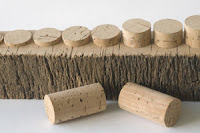Put a cork in it…if you are a traditionalist, then this might be your mantra when it comes to that bottle of wine you are about to purchase. Lately there has been a lot of discussion about what might be the best stopper for wine bottles: cork, screwcap, glass, synthetic? I thought it might be worth taking a look at cork (we’ll look at the other stoppers next week) and see what it is and why it’s used.
Cork is actually the bark of the Cork Oak tree. These trees grow mainly in Southwest Europe (Portugal and Spain account for over 80% of cork production). Every ten years, the bark is stripped from mature cork trees (at least 25 years old). This process does not harm the trees, which can live over 200 years. The harvesting of cork takes place during May to August, when the cork separates easily, without causing damage to the tree.
Because of the cellular structure of cork, it is easily compressed when inserted into a bottle and will expand to form a tight seal. The interior diameter of the neck of glass bottles tends to be inconsistent, making the cork’s expansion and contraction an important feature. Natural cork stoppers are important because they allow oxygen to interact with wine for proper aging, and are best suited for red wines purchased with the intent to age. However, natural flaws and cracks in the cork bark make its’ sealing ability a bit inconsistent. This would cause the wine to age too fast, even to the point of being oxidized.
The biggest complaint about cork is “cork taint” or “corked wine” What this refers to is a wine fault. There is a noticeable odor that is often described as “moldy newspaper”, “wet dog”…or to me “chlorine”. This is a chemical reaction caused by 2,4,6-trichloroanisole (TCA). However, in recent years major cork producers have developed methods that remove most TCA from natural wine corks. It’s now thought that TCA may actually occur in the barreling process.
When you are in a restaurant, and the Sommelier hands you the cork, what are you suppose to do? Don’t bother smelling the cork, it won’t tell you anything. But do look at it. You can tell several things from a cork. Many are marked with the place the cork was made, as well as the winery the wine came from. The narrower and more misshapen the cork, the longer the cork has been in the bottle. You should also look at the “mirror” (the portion of the cork that has been in contact with the wine). Sometimes you will see small crystals - this is not broken glass, but merely tartrates (or “wine diamonds”), a harmless substance sometimes found in wine that hasn’t been cold stabilized. Also, if the wine has stained up the side of the cork, this may be an indication that the cork has failed, and the wine might be oxidized.
Next week, we’ll take a look at some of the other wine stoppers, and let you determine which you prefer.




This was very interesting. I didn't know that "a little" oxygen" is necessary to age the wine. I always find it interesting that it is much easier to put the cork back in the bottle upside down, although that situation actually doesn't come up often at our house.
ReplyDeleteIf you do "recork" your wine, add a little inert gas to the bottle before you put the cork back in. You can buy cans of the gas at your local wine shop (only about $10). I use a vacuum seal on unfinished bottles (which also doesn't happen that often), then store in the refrigerator for no more than a couple days.
ReplyDeleteThis comment has been removed by a blog administrator.
ReplyDeleteWine stopper...I appreciate your comments. At this point, I am writing articles on a weekly basis, and would love to add more (time is a bit of a constraint). If you have ideas/subjects, feel free to add them here, and I will do my best to respond, and/or write articles within my scope of expertise.
ReplyDeleteIt is extremely helpful for me. If possible, as you gain expertise, would you mind updating your blog with more information?wine stoppers
ReplyDeleteWine stoppers....as mentioned above, I'm writing new articles weekly, and looking for subject that people want to discuss. Last week, I started a discussion on German wines, this week, I'll be following up with how to read a German wine label. I'm looking for ideas, so if you have a topic you are curious about, let me know, and I write about it.
ReplyDeleteHey, just so you know: "wine stoppers" up there is actually just a spam machine. It writes ingeniously crafted comments so general they apply to any subject, and inserts a link in the end to the advertised brand.
ReplyDeleteAndre...yeah, I figured that out a while ago. Probably should have deleted those comments, but it appears their links don't work anymore. Thanks for the comment!
ReplyDeleteI discovered your blog just as I was getting into wine seriously and learned a lot from your well written, humble and informative posts.
ReplyDelete